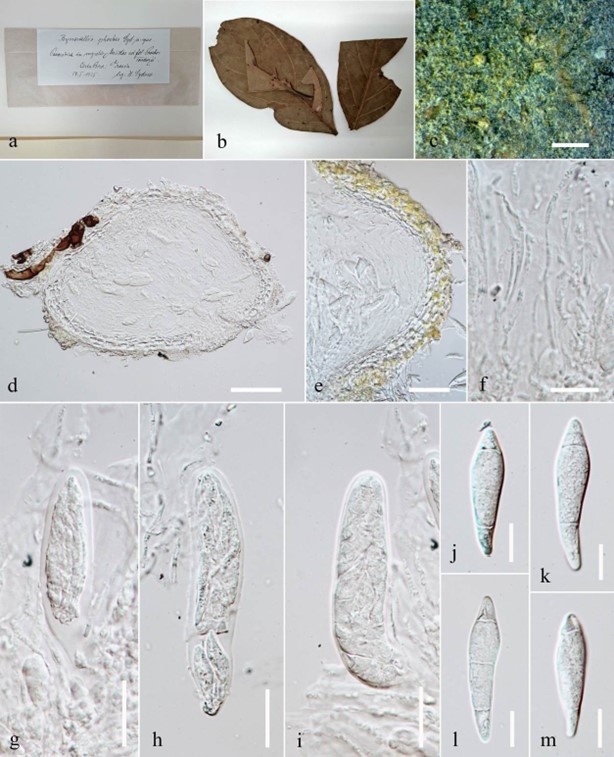Byssocallis phoebes Syd., Annls mycol. 25(1/2): 14 (1927) Fig. 24
MycoBank number: MB 274271; Index Fungorum number: IF 274271; Facesoffungi number: FoF 06224;
Parasitic on mycelium of leaves of Phoebes jonduzii. Sexual morph: Ascomata 92–113 μm high × 105–117 μm diam. ( x = 103.1 × 111.4 μm, n = 10) superficial, distributed throughout upper and lower surface of leaf, solitary, subglobose-globose, light yellow to orange-brown, with an opening at the centre, concealed with light brown mycelia. Peridium 22–25 μm thick, comprising 3–4 layers of pale yellow cells of closely arranged textura angularis. Hamathecium 1–1.5 μm wide comprising numerous filiform, branched, septate pseudoparaphyses embedded in a gelatinous matrix. Asci 69–74 μm × 15–18 μm ( x = 71.5 × 16.8 μm, n = 10), 8-spored, bitunicate, cylindrical to clavate, slightly curved, short pedicellate, apically rounded with a small ocular chamber. Ascospores 28–31 µm × 8.4–9.1 µm ( x = 29.7 × 8.7 µm, n = 20), fusiform to clavate, wedge- shaped, upper part wider than lower part, 3- transversely septate, slightly constricted at the septa, hyaline to grayish, slightly granulate, smooth-walled. Asexual morph: Undetermined.
Material examined – COSTA RICA, Central America, San Pedro de San Ramon, Provincia de San José on Phoebe costaricanus (Lauraceae), 23 January 1925, H. Sydow (E00455471, syntype).
Economic significance – The genus Byssocallis is parasitic and has been reported to cause disease leaves that occur in Meliolaceae (Boonmee et al. 2011).

Figure 24 – Byssocallis phoebes (E00455471, syntype). a–c Herbarium specimen and habit on leaf. d Section of an ascoma. e Peridium. f Hamathecium. g–i Asci. j–m Ascospores. Scale bars: c = 500 μm, d = 50 μm, e–i = 20 μm, j–m = 10 μm.
